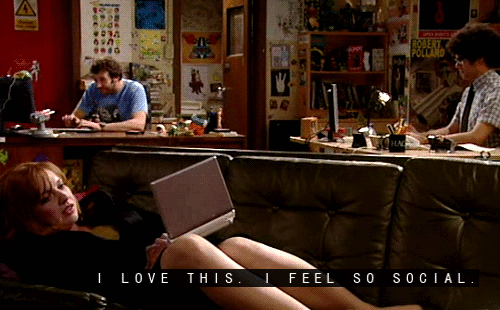Have we become the bleak dystopia audiences have feared?
We all know how the media has focused online users (AKA Millennials) as: lazy, preoccupied, rude, arrogant. This generation is perceived as uncontrollable, gluttonous individuals mesmerised by screens with an unattainable lust for likes. All of this attributes to one truth: society regarding a dystopian outlook because of fears to new forms of media.
The dystopian perspective is nothing new. Every new media form inspired anxieties about it’s possible negative effects. Only consider:
- Gustave Le Bon, The Crowd: A Study of the Popular Mind, 1896 – “The unreal has about as much influence on them as the real…”
- George Orwell’s novel 1984 – totalitarian society monitoring everyone’s single move with camera’s and new technologies
- 1995 – Destructive video games considered unhealthy for kids
- Wall-E (2008) – A human dystopia/utopia; people looking at screens; are the screens the cause of their obesity?
- The End Specialists By Drew Magury (2012) – science’s evolution in creating immortality outlines the negatives in achieving eternity
“Research on the media’s capacity to evoke children’s emotions has focused on its ability to arouse their fears and anxieties.” Barbara J. Wilson on Media and Children’s Aggression, Fear, and Altruism
Accordingly, Wilson’s theory of children’s emotions spiked by the media is encouraged by Bandura’s Bobo Doll Experiment. This is in which adults punched, kicked and hit a large Doll while being watched by young children, who then were placed in the same room with toys. Many children copied the adults and preoccupied their time with punching the Doll instead of playing with the other toys. As such, this demonstrated his theory of the “social learning of aggression.”
The exposure to violence through the media and its effects on kids suggests that violence viewed through a screen can have as much effect on an individual as if they were witnessing it first-hand.
Think only of new gifs, posts and articles wholeheartedly agreeing on the destructive nature of media as well.



Merely searching Huffington Post for social media anxieties and a variety of stress and fear rises. Additionally, new anxieties of social media include cyber-bullying, harrassment, social isolation, and anti-social behaviour.
These representations of new mass audiences include:
- Easily influenced
- ‘Feminised’
- ‘Childlike’
- ‘Passive’
Ultimately, fears about the ‘effects’ of the new mass media on the behaviour of children, the youth, uneducated, and the working class have arisen. But society uses technology to create both positive and negative things throughout history. It’s easier to blame the media than to find the ‘real’ cause of issues within a community.
Maybe it’s not the media that we should be questioning – but the ethics and morals of individuals.
Till next time,
Jess

I have read a few blogs on the topic of media audiences but I found that yours stuck with me the most! I enjoyed the different approach you took to the topic, referencing a lot of background information on this issue. I think that the timeline you posted was really informative, with my only constructive criticism being that I would’ve liked to see a few more examples posted within it as I think it was a great guide to how this issue has grown and developed over the years. Really enjoyed this blog, cant wait for next week.
LikeLike
Thank you so much for your feedback! I really appreciate all of what you said, when I was writing I didn’t even consider it was a timeline I wrote, and I would have liked to research more into further examples of the extension of media anxieties. Hopefully next week I do
LikeLike
Once again a magnificent piece of writing Jess! you really grasp the concept and obviously understand the content enough for it to be explained easily. I find it fascinating to consider weather its ‘us’ or the ‘media’ who should take responsibility for the effort lacking in todays society. Breaking the content down and giving clear examples, i.e.
Easily influenced
‘Feminised’
‘Childlike’
‘Passive’
makes it very obvious how new breeds of audience are beginning to circulate around media.
More information regarding the “Bo-Bo doll” would have furthered any understanding, as well as giving a more detailed insight into relatively historical studies of the social learning of aggression.
All in all a great blog which I intent to follow constantly 🙂
-Sarah
LikeLiked by 1 person